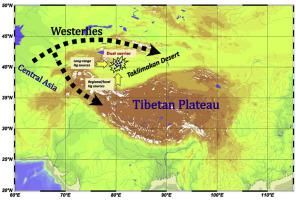Environmental Pollution ( IF 7.6 ) Pub Date : 2020-09-08 , DOI: 10.1016/j.envpol.2020.115442 Jie Huang , Shichang Kang , Runsheng Yin , Kirpa Ram , Xinchun Liu , Hui Lu , Junming Guo , Siyu Chen , Lekhendra Tripathee

|
The atmospheric circulation plays a critical role in the global transport and deposition of atmospheric pollutants such as mercury (Hg). Desert dust emissions contribute to nearly 60 to 95% of the global dust budget and thus, desert dust may facilitate atmospheric Hg transport and deposition to the downwind regions worldwide. The role of desert dust in biogeochemical cycling of Hg, however, has not been well recognized by the Hg research community. In this study, we measured the concentration of particulate bound Hg (HgP) in total suspended particulate (TSP) collected from China’s largest desert, Taklimakan Desert, between 2013 and 2017. The results show that HgP concentrations over the Taklimakan Desert atmosphere are remarkably higher than those observed from background sites in China and are even comparable to those measured in most of the Chinese metropolitan cities. Moreover, HgP concentrations in the Taklimakan Desert exhibit a distinct seasonal pattern peaking during dust storm outbreak periods in spring and summer (March to August). A preliminary estimation demonstrates that export of total Hg associated with atmospheric dust from the Taklimakan Desert could be 59.7 ± 60.3 (1SD) Mg yr-1. The unexpectedly high HgP concentrations during duststorms, together with consistent seasonal pattern of Hg revealed from the snow/ice, clearly demonstrate that Asian desert dust could act as a significant carrier of atmospheric Hg to the cryosphere of Western China and even can have further global reach.











































 京公网安备 11010802027423号
京公网安备 11010802027423号